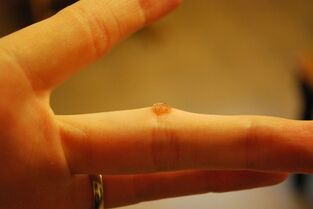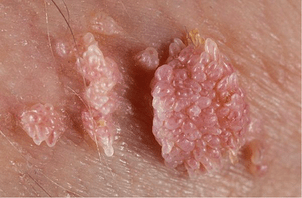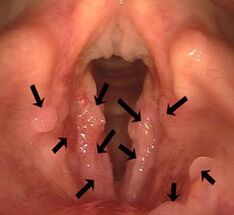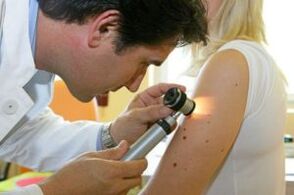Papillomas are benign tumors that are localized on the skin and mucous membranes. They arise due to the activation of the human papillomavirus (HPV) and there are many different types. Some of them are harmless and only create a cosmetic defect, others are potentially dangerous and can develop into a cancerous tumor.
Mechanism of papilloma generation
The appearance of a particular type of cancer depends on the type of virus a person gets sick with. Distinguishing between low-carcinogenic strains, in which developed strains pose no great danger to the carrier and the high cancer-causing strains. Neoplastic cells appear due to the papillomavirus virus, the activity of this virus leads to excessive cell division, resulting in gradual growth.
"safe" papillomas usually occur on the skin, while most worrying is localized in the mucous membranes.Such tumors often cause highly cancer-causing viruses. For women, having genital warts can be dangerous to cervical cancer.

Common papilloma (warts)
One of the most common manifestations of HPV, commonly referred to as "warts". Their appearance is often due to the low activity of cancer-causing strains, transmitted through contact and everyday life.
Warts usually appear on the fingers, palms, soles of the feet or feet.
On the surface, they look like small papillae with uniform structure. Common papillomas are soft to the touch, and when the disease first begins, their pigmentation is weak: the actual color is no different from the body color.
However, as the disease progresses, the papules grow and begin to darken. Sometimes hair can grow in the center of the wart.
Fibrous papilloma
This type of papilloma gets its name because of its small legs, whereby the tumor rises above the surface of the skin. The growth is distinguished by an elongated shape and measures approximately 5 mm. Usually, papillomas are located in the thinnest areas:
- chest; Ancient
- ;
- eyelids;
- groin area;
- armpits.
Filamentous papillomas are usually more typical in patients over 45 years of age, but they sometimes occur in young people as well. Tumors tend to grow larger as the disease progresses.Gradually they begin to strain.
The first part of the papilloma is yellow or pink, with no apparent pigmentation. A keratosis is rarely found. With trauma, pain is not observed. Others may appear on the site of an damaged fibroid. If it grows on the face, you should stop using a brush or scrub. In the armpit area, papillomas are also often damaged by the razor, which adversely affects the health of the patient.

Flat papilloma
This type of papilloma is also localized on the skin and resembles small patches. Flat papillomas are yellowish in color, not more than 1-2 mm in size. Structurally, the clumps are dense, their base is below the skin. Therefore, at the moment of injury or pressure, pain can occur. Additionally, this structural feature sometimes leaves scarring after removing the buildup.
Typical symptoms accompanying flat papilloma:
- reddening of the skin around the growth site;
- itching;
- pain to the touch; inflammation
- .
Usually, pimples grow on the face or hands, but sometimes they appear on the genitals. In women, they are usually located on the labia, in men, on the scrotum or on the anus. Flat papillomas increase in size rapidly and bleed during trauma.
Genital warts

These tumors are usually located in the groin or mucosa. They are caused only by strains of HPV when having unprotected sex. Usually they press:
- vagina;
- pussy;
- cervix;
- anal area;
- scrotum;
- penis.
The growth is similar to thin papillae, they are small - 2-3 mm. Usually, the virus is not limited to the appearance of a single tumor. Warts are characterized by the appearance of multiple pimples at the same time, gradually fusing together. Tumors rapidly grow in size and grow. At this point, their shape begins to resemble cauliflower clusters.
Genital warts are considered one of the dangerous papillomas.Apart from the fact that these tumors can degenerate into a malignant tumor, the infection is often associated with them. In addition, the tumor is likely to recur after resection, so patients will have to periodically examine to control the level of HPV.
In rare cases, fibroids can form on internal organs such as the wall of the stomach or rectum. In this case, it is not possible to diagnose the presence of cancer on its own. The lack of specific symptoms can become a problem in diagnosing and treating the disease.
Lewandowski-Lutz papilloma
A fairly rare type of papilloma. They usually occur in the feet and hands. One distinctive feature of the folds is the uneven edges. They are usually brown in color, but sometimes they can be a dark red color. This form of the disease can also contribute to malignant tumors, so patients should consult their doctor as soon as possible.

Tree warts
These growths are more typical in children and adolescents, and rarely occur in adulthood. It is considered a common body response to impaired immunity, accompanied by insole injury caused by uncomfortable wearing of shoes. Unlike regular calluses, warts are coarse and have jagged edges. In addition, the skin tissue is clearly visible on the scar tissue.
Plantar warts are characterized by a small spot on the skin's surface and a large root that grows under the skin. Usually it is completely keratinized due to constant wear and tear when walking. Over time, growth increases, squeezing or touching them causes discomfort and pain.
Due to the texture of the wart, it is very difficult to remove the wart because most of them are inside. Therefore, after resection, stitches are often required and may leave scarring at the site of the procedure.
Adolescent papilloma
Most infections occur in babies under 5 years of age, as the infection usually occurs during birth. If a pregnant woman is a carrier of the papillomavirus and has genital warts, the baby is very likely to become infected.

Juvenile papilloma located on the skin is not dangerous. However, they can also be localized in the larynx, making it difficult for the baby to breathe. In the early stages, no signs of the disease are observed. After a while, the following symptoms appear:
- the feeling of a lump in the throat;
- has difficulty swallowing saliva or food;
- impaired respiratory function.
In older children, the voice can change, which is characteristic of ligament damage. Papillomas can develop and cause asthma attacks, which could one day stop your breathing completely.
Papilloma
Papilloma is a condition in which the number of tumors suddenly increases and spreads throughout the body. It is also known as generalized papilloma virus. Most often, a large accumulation of papillomas appears on the hands, face, genital area. Papillomatosis, occurring in the mucosal region or on internal organs, is potentially dangerous to humans.
Usually, papilloma is referred to when a juvenile papilloma appears in the larynx. They are the ones that tend to overgrow.

Conclusion
Although there are relatively safe types of papilloma, each type of papilloma should be checked regularly by a specialist. This will help control their growth and remove them promptly if necessary. In addition, it is important to remember that the presence of a tumor is a sign of an infection with the papillomavirus, which also requires prompt treatment.

























